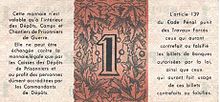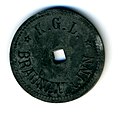Storage fee

|

|
|
|
Camp fees Great Britain ( internment camp Isle of Man ) in World War II
|
||
As storage charges a form of will Token referred to in internment or prisoner of war camps to the occupants rather than regular money is spent to ensure in case of escape, that the occupants do not have cash.
The money that was spent on the prisoners in the concentration camps and ghettos during National Socialism is also called camp money. This camp money or ghetto money was also used to plunder and deprive prisoners of their rights.
history
The first camp money was spent by the Austrian army in a prisoner-of-war camp for Prussian officers near Dresden during the Seven Years' War . The oldest warehouse receipts still in existence today come from the Camp Douglas prisoner-of-war camp near Chicago, which was established between 1861 and 1865 as part of the American Civil War . During the First World War there was an abundance of different camp money expenditures because there were no uniform regulations and each camp administration developed its own models.
The Geneva Convention on the Treatment of Prisoners of War of July 27, 1929 regulated in § 6 and § 24 that the prisoner of war had to hand over his cash , but this had to be refunded to him in the same currency after the captivity. To implement this, the prisoners were given vouchers for the money they had given, which were used as camp money. Officers in captivity of war also received wages from the victorious power, which were paid in camp money.
During the First World War, many of the numerous Austro-Hungarian POW camps used their own coins and banknotes as storage money. A distinction was sometimes made between officers and men.
During the Second World War , the storage fee was standardized in both Germany and France . In this way, all soldiers received uniform certificates regardless of the camp in which they were interned.
See also
Web links
- (Ernst) von Nischer (1879–1961): storage fees. In: Donauland. Illustrated monthly , year 1917, no. 1/1917, p. 90. (Online at ANNO ). .
Individual evidence
- ^ Albert Pick : Paper money. A guide for collectors and enthusiasts . Klinkhardt & Biermann, Braunschweig 1967, OBV , pages 58-64.
- ↑ Geneva Convention on the Treatment of Prisoners of War of July 27, 1929





